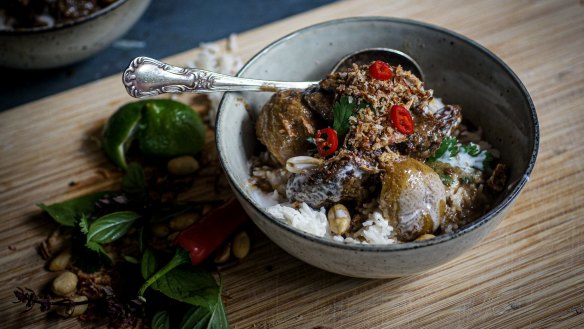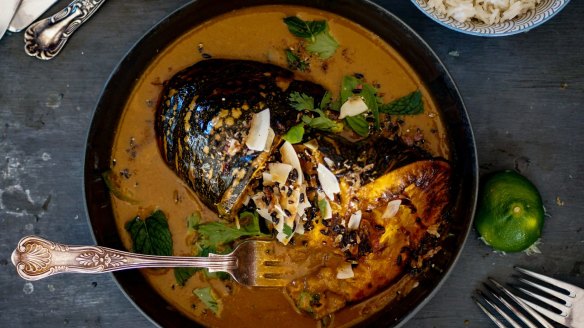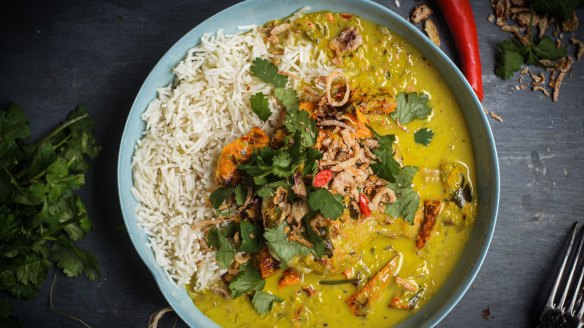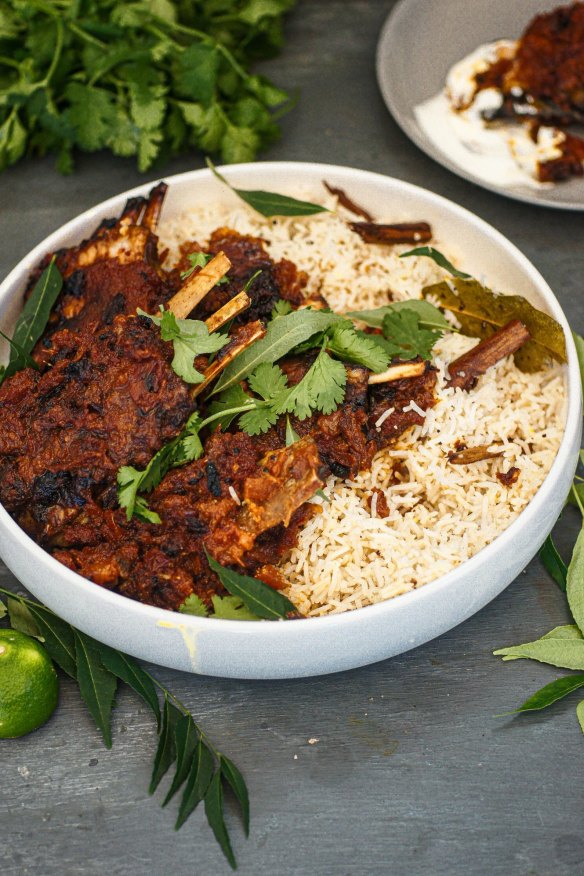Cheap cut curries to get massaman bang for buck

These four curries run the gamut of fragrant and heavily spiced to the kind of heat and sweat that will have you wondering if you need to wash your hair.
Cheaper cuts from chicken thighs to lamb ribs and beef cheek have been slow-cooked, turning them into glorious, flavour-packed curries to take that bite out of the winter air.
There are a few key magical steps to a great curry:
1. When time allows make your paste. It pays dividends in comparison to store-bought jar versions.
2. Timing: Cook your paste until it splits, add the coconut milk or cream and cook until it splits. Everything after this will often take care of itself.
3. Season at the end of cooking. A good curry is about balance: heat, spice, sweet, sour and salty.
All recipes serve 6
Beef cheek massaman
This curry is deep, dark and soothing – the beef cheeks having had a wonderful wallow in the massaman. Be careful when seasoning the finished curry with tamarind extract, the strength of tang varies considerably between brands. Add it slowly – you can always add more, you just can't take it out.
INGREDIENTS
Massaman curry paste
7 red chillies, roughly chopped (remove some seeds for less heat)
1 tbsp coriander seeds, toasted
3 tsp cumin seeds, toasted
½ tsp cardamom seeds, toasted
6 cloves
⅓ cup roasted unsalted peanuts
5 large eschallots, roughly chopped
1 tbsp brown sugar
Curry
2 cinnamon quills
2 bay leaves
1 tbsp coconut oil
1kg beef cheeks, trimmed of sinew
1 x 400ml tin coconut cream
1 x 400ml tin coconut milk
2 tbsp tamarind extract
½ cup master stock, if required
500g desiree potatoes, quartered (skin-on so they hold their shape)
3 tbsp palm sugar
juice and zest of 1 lime
50ml fish sauce (or to taste)
1 tsp ground coriander
additional tamarind extract, to taste
To serve
steamed rice
¼ cup fried shallots
½ red chilli, finely sliced
coriander leaves
METHOD
1. For curry paste, add all ingredients to a food processor and blitz to combine and until a relatively smooth paste forms. If the mixture keeps catching, add one tablespoon of water to help smooth the paste.
2. Place a large heavy-based saucepan over medium-high heat. Dry roast the cinnamon quills and bay leaves for 30 seconds. Add the coconut oil and the beef cheeks and brown briefly on all sides. Remove the beef cheeks and set aside.
3. Add the curry paste and cook until it becomes fragrant and splits. Add the coconut cream, coconut milk and tamarind extract.
4. Return the beef to the saucepan. Cover and cook over low heat for 3½ to four hours. Keep an eye on it, the sauce should reduce enough so by the end of the cooking time it is only just covering the beef. If it is reducing too quickly, top up with ½ cup of master stock or water.
5. Remove the lid, add the potato and simmer until the potatoes are soft (about 20 minutes). Season to taste with the palm sugar, lime, fish sauce, ground coriander and a little tamarind extract. Taste as you go – you want a balance of salty, sweet and sour with a dusky warmth from the coriander.
6. Remove the cinnamon stick and bay leaves (optional). Serve with steamed rice and top with fried shallots, fresh chilli and coriander, if using.

Rendang pumpkin curry
I only use half the rendang paste this recipe makes – stash the remainder in the freezer for when the emergency need for curry calls.
Puffed black rice is available from health food stores or make your own (see below). It adds a spectacular crunch to this recipe. The roasted pumpkin skin contrasts against the softness of the caramelised pumpkin and the curry sauce.
INGREDIENTS
1 Jap pumpkin (about 1.5kg), cut into 4-6 thick wedges
2 tbsp coconut oil
1 tbsp brown sugar
2 tbsp Malaysian curry powder (I recommend Herbie's Malay curry powder)
500ml master stock
1 x 400ml tin coconut milk or coconut cream
Rendang paste
8 red chillies, roughly chopped (seeds removed if you want to reduce the heat)
6 cloves garlic, roughly chopped
5cm piece of ginger (about 30g), roughly chopped
2 small red onions, roughly chopped
½ cup coconut oil
1 tbsp Malaysian curry powder
1 cup shredded coconut, toasted
6 fresh curry leaves
1 tbsp paprika
½ tsp ground cinnamon
½ tsp ground coriander
1 tbsp brown sugar
juice of 1 lime
To serve
fresh coriander leaves (about 1 tbsp per serve)
¼ cup toasted coconut flakes
¼ cup puffed black rice*
¼ cup fried shallots
steamed rice or coconut rice
METHOD
1. Preheat oven to 175C and line a large baking tray with baking paper.
2. Add the pumpkin wedges, oil, sugar and curry powder to a bowl and toss to coat. Arrange on the prepared tray and roast in the oven for 45 minutes or until cooked through and caramelised on the edges.
3. While the pumpkin is cooking, make the rendang paste. Put the paste ingredients in a blender and blitz into a coarse paste. Ensure the fibrous bits of lemongrass have been properly macerated in the paste. (Reserve half the paste for another use.)
4. Place a large saucepan over medium heat. Add the paste and cook until fragrant and it starts to split. Add the coconut cream or coconut milk and cook until it looks like it has split. Add the master stock then reduce and simmer for the remainder of the time the pumpkin is cooking (about 40 to 50 minutes). The curry sauce should reduce by about one third and thicken slightly. If the sauce hasn't thickened by the end of the pumpkin's cooking time, continue to simmer over a low heat until it generously coats the back of a spoon. Alternatively, if your sauce is reducing too rapidly, slowly add coconut milk or stock, about one tablespoon at a time.
5. To serve transfer the pumpkin wedges to a large serving bowl. Pour over the reduced rendang sauce and top with coriander leaves, coconut flakes, puffed rice and fried shallots. Serve immediately with steamed rice or coconut rice.
*To make puffed black rice heat two cups of rice bran oil in a medium saucepan until sizzling. Throw in a grain of rice and if it sizzles and swirls on top, the oil is hot and ready to go. Add one-quarter cup raw black rice grains and fry until the rice puffs a little and you can see marks of white on the grains – this will happen very quickly (15 to 30 seconds). Remove using a slotted spoon, shake off excess oil, then place on a plate lined with paper towel to dry completely. Leave the oil to cool, then strain into a container for another use.

Lemongrass, turmeric, coconut and kaffir lime chicken curry with roasted sweet potato
The flavour profile here is more fragrant and spiced than any real hit of heat. If you love a curry that brings out a flush in the cheeks, feel free to add a few more chillies to the paste. Given the more delicate nature of this curry sauce, it also works with fish.
INGREDIENTS
500g sweet potato, peeled and cut into 2-3cm cubes
3 tbsp coconut oil
1 heaped tsp fresh galangal (or 1 tsp ground galangal)
Curry paste
1 tsp ground turmeric
1 x 5cm piece fresh ginger, roughly chopped
2 lemongrass stems, pale part only, chopped
2 garlic cloves, roughly chopped
1 red chilli
2 eschallots, roughly chopped
4 kaffir lime leaves, deveined and thinly sliced
½ tbsp coconut oil
Curry
½ tbsp coconut oil
400ml coconut cream
800g free-range chicken thigh fillets, halved
1 tbsp fish sauce
1 tbsp brown sugar
small pinch salt
juice and zest of 1 lime
To serve
fried shallots
freshly sliced red chilli (optional)
coriander leaves or additional finely sliced kaffir lime leaves
lime wedges (optional)
METHOD
1. Preheat the oven to 180C and line a baking tray with baking paper.
2. In a medium-sized bowl, toss the sweet potato, coconut oil and galangal to coat. Spread out onto prepared tray and bake until the sweet potato is soft. Remove and set aside.
3. While the sweet potato is roasting, prepare the curry. Add the paste ingredients to a food processor and blitz to a fine paste.
4. In a heavy-based large saucepan add half a tablespoon of coconut oil and place over high heat. Add the curry paste and cook, stirring, for five minutes or until the oil has split from the paste and it is very fragrant.
5. Reduce the heat to medium, add the coconut cream and cook for an additional five or so minutes. Add the chicken, cover and cook for about eight to 10 minutes – the sauce shouldn't be bubbling, it should simmer over a gentle heat to ensure the chicken is poached evenly. Just before serving add the fish sauce, sugar, salt and lime juice and zest then check for seasoning. Add the roasted sweet potato pieces and cook until warmed through (about five minutes).
6. Serve with steamed rice and top with fried shallots, chilli and kaffir lime or coriander, with lime wedges on the side, if using.
Lamb rib kasoundi with ginger, cardamom and coconut pilaf
This is the ultimate hack. Using store-bought kasoundi (Indian relish), this is cheating at its finest. Add the ribs and the five-second sauce to a large roasting dish, shove in the oven and forget.
A word of caution: taste the kasoundi first. If it seems sweet, adjust the marmalade quantity accordingly. You want the sugars for caramelisation as the sauce reduces, but not an overload of sweet, it will override the heat and tang of a good kasoundi. While the orange marmalade might seem an odd choice, it adds a lovely background tartness to the sweetness of the lamb.
I asked my butcher to cut the ribs into lots of three – this seems to be the easiest size for fitting into various baking dishes without too much overlap.

INGREDIENTS
1 x 400g tin chopped tomatoes
370g quality store-bought kasoundi (I used Goan Cuisine brand)
½ cup orange marmalade, or to taste
1.5kg lamb ribs
salt and pepper, to season
Pilaf
1 tbsp ghee
1 red onion, finely sliced
12 cardamom pods, bruised
1 cinnamon quill
1 bay leaf
1 ½ cups chicken stock
½ cup coconut milk
2-3 (small pinch) saffron threads
1 ½ cups basmati rice
¼ cup sultanas
1 x 3cm knob ginger, peeled, finely grated
METHOD
1. Preheat oven to 150C.
Add the tinned tomatoes, kasoundi and marmalade to a large bowl. Add the lamb ribs, season with salt and pepper and toss to coat. Turn out into a large high-sided baking dish. Where possible, spread into a single layer to ensure the lamb browns – the odd overlap is fine.
2. Cover with a piece of baking paper cut to fit the dish, then cover tightly with foil. Roast for 3½ to four hours or until the meat is charred, caramelised and falling off the bone, and most of the liquid has cooked out. Check on the ribs halfway through cooking and gently turn them to ensure even cooking. If the kasoundi coating seems dry, add a splash of chicken stock (no more than one quarter cup at a time) and return to oven.
3. Towards the last half hour of cooking, begin the pilaf. Heat the ghee in a large saucepan over medium-high heat. Add the onion, cardamom, cinnamon and bay, season, and sauté until onion has softened and translucent (four to five minutes).
4. Add rice and stir to coat, then add chicken stock, coconut milk and saffron threads and give it a good stir so the saffron softens. Bring to the boil. Cover with a tight-fitting lid, reduce heat to low and simmer for 14 to 15 minutes.
5. Remove pan from the heat. Add sultanas and grated ginger, re-cover with the lid and stand for five minutes, then fluff with a fork and serve with the ribs.
Find more of Katrina Meynink's recipes in the Good Food Favourite Recipes cookbook.
